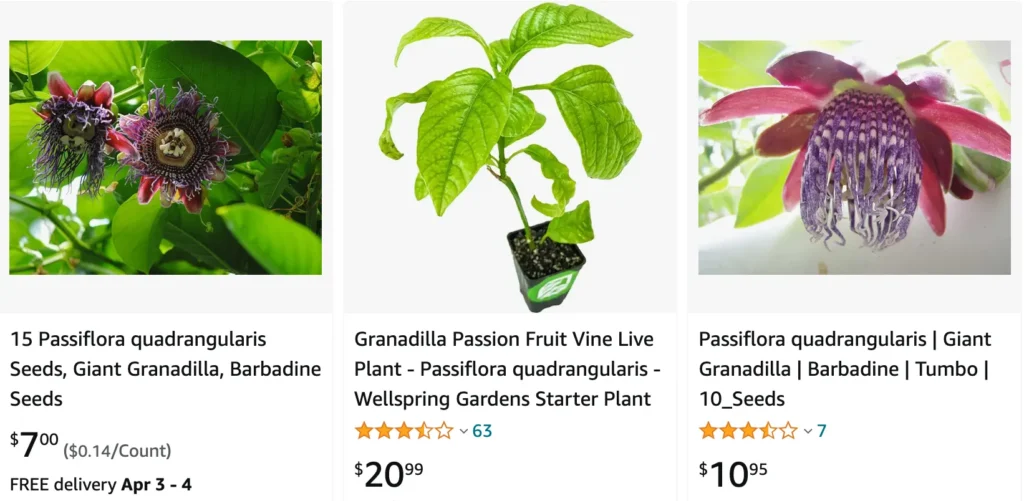
Introduction
Hello there! Today, I want to share my personal experiences and discoveries about Passiflora quadrangularis, commonly known as the giant granadilla, barbadine, or badea. This unique plant, belonging to the Passifloraceae family, has intrigued me with its fascinating characteristics and diverse uses. Join me on this journey as I delve into the captivating world of Passiflora quadrangularis.
Unveiling the Beauty: Description of Passiflora Quadrangularis
In my encounters with Passiflora quadrangularis, I’ve been captivated by its vigorous and tender nature. The evergreen perennial climber boasts nodding red flowers, each adorned with white and purple filaments, creating a mesmerizing display. The smooth, cordate leaves, petioles with multiple glands, and the distinctive large, oblong fruit further add to the plant’s allure. My personal experiences have allowed me to appreciate the intricate details of Passiflora quadrangularis, making it a standout species within the Passiflora genus.
A Gastronomic Adventure: Culinary Uses and Discoveries
According to my actual experience, the giant granadilla offers a culinary adventure like no other. The edible pulp surrounding the seeds has a sweetly acid taste, making it a delightful addition to various dishes. I’ve explored the versatility of this fruit, from using the immature fruit in vegetable curries to extracting its juice for refreshing beverages. The roots of old plants, when baked or roasted, provide a unique yam-like flavor, although caution is advised due to the narcotic and poisonous nature of the raw root.

Passiflora Quadrangularis as Medicine: Unveiling Its Healing Properties
Intriguingly, it extends its utility beyond the kitchen. My research and experiences have revealed that the plant has medicinal properties, with the root being diuretic, emetic, narcotic, and vermifuge. Passiflorine, an anthelmintic compound found in the root, adds to its therapeutic value. The leaves, when infused, serve as an antiscorbutic, while the fruit and its components are recognized for their sedative properties. I’ve personally explored the traditional tea made from the leaves, finding it to be a soothing remedy for conditions like high blood pressure and diabetes.
Passiflora Quadrangularis as an Ornamental Marvel
As I ventured further into the realm of Passiflora quadrangularis, I discovered its role as an ornamental plant. Requiring a minimum temperature of 15°C, the plant graces gardens and greenhouses with its aesthetic appeal. The Royal Horticultural Society’s Award of Garden Merit speaks volumes about its desirability in ornamental horticulture. In my own gardening endeavors, I’ve witnessed the charm Passiflora quadrangularis brings to outdoor spaces.
Getting to Know Passiflora Quadrangularis: General Information
Understanding the general characteristics of Passiflora quadrangularis has enhanced my appreciation for this evergreen climbing shrub. Its ability to produce long stems, coupled with its tolerance for pruning, makes it a versatile addition to various landscapes. Learning about its original range, habitat preferences, and cultivation details has deepened my understanding of the conditions that foster its growth.
Hazards and Precautions: Navigating the Potential Dangers
As with any intriguing plant, it comes with its share of hazards. I’ve come to realize that the raw root possesses potent narcotic and poisonous qualities. However, the traditional knowledge of counteracting these effects with specific decoctions adds an interesting layer to my exploration.
Passionate About Propagation: Growing Passiflora Quadrangularis
In my journey with Passiflora quadrangularis, I’ve explored various methods of propagation, from seeds to cuttings and even air layering. Understanding the plant’s preferences for soil, temperature, and fertility has been crucial in successfully cultivating this species. The diverse uses and potential varieties have fueled my enthusiasm for experimenting with different propagation techniques.
The Culmination: Harvesting and Utilizing the Fruits
Harvesting the fruits of Passiflora quadrangularis is a rewarding experience. I’ve learned to identify the signs of readiness, such as translucent and glossy skin with a yellowish hue at the apex. Careful handling and storage techniques ensure the longevity of the fruit, allowing for extended enjoyment. Exploring various culinary creations with the ripe fruit has been a delightful aspect of my journey with Passiflora quadrangularis.
Challenges in Cultivation: Navigating Environmental Factors
Cultivating Passiflora quadrangularis comes with its challenges, particularly in managing environmental factors. I’ve faced issues with wind damage, and I’ve learned to address concerns related to pests and diseases. The plant’s sensitivity to temperature, soil conditions, and irrigation practices has shaped my approach to its cultivation.
Conclusion: A Personal Affair with Passiflora Quadrangularis
In conclusion, my journey with Passiflora quadrangularis has been a deeply personal affair. From the initial fascination with its ornamental beauty to the culinary experiments and exploration of its medicinal properties, each encounter has been a unique experience. The challenges in cultivation have only added to the richness of this journey, making it a plant that continues to intrigue and inspire me. As I look forward to future interactions with this remarkable species, I’m excited about the discoveries that lie ahead in my ongoing exploration of Passiflora quadrangularis.



